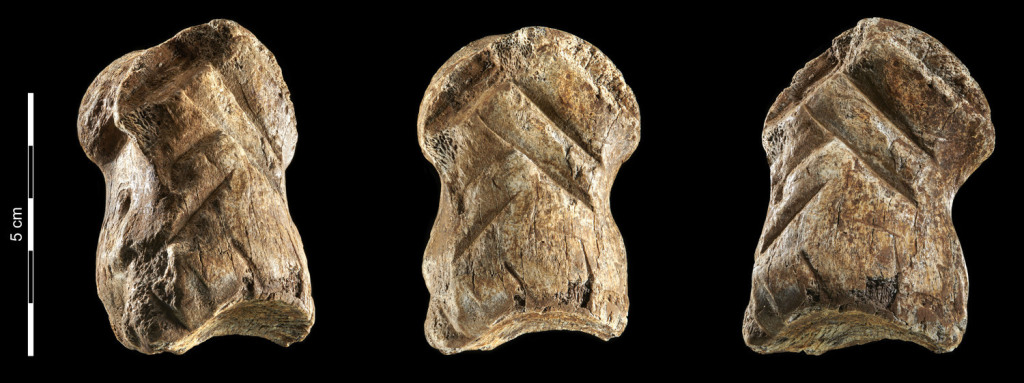ART WORLD NEWS
Neanderthal Carving Discovered in Germany’s Unicorn Cave
Germany’s Einhornhöhle, or Unicorn Cave, in the Harz Mountains got its name from the treasure hunters who thought fossilized remains in the dark passages belonged to unicorns. Archaeologists digging at the site recently found something almost as unlikely: a 50,000-year-old deer bone with a geometric pattern carved by Neanderthals. The discovery, reported on Monday by a team of researchers from the University of Göttingen and the Lower Saxony State Office for Heritage, adds to a growing body of evidence that Neanderthals created symbolic objects—perhaps what we would call art.
Artifacts found at Unicorn Cave in the 1980s proved the site was actually a hideout for Neanderthals during the Middle Paleolithic period (roughly 300,000 to 30,000 years ago). A German team of archaeologists revisited the cave in 2014 for new excavations, and, in 2019, while investigating the untouched layers of Ice Age soil buried there, they found well-preserved animal bones with cut-marks. Among them was the toe bone of a prehistoric (and now extinct) giant deer.
Related Articles
“It showed six groves which together form a chevron-like decoration,” said Thomas Terberger, a prehistoric archaeologist at the University of Göttingen in Germany and one of the authors of the new study in Nature Ecology & Evolution, in an email to ARTnews. Radiocarbon dating proved the object dated to 51,000 years ago—when Neanderthals were the only human species roaming this part of Europe—and analysis on the bone showed that these etchings weren’t butchering marks. (The researchers even performed some of their own experiments carving cow toe bones, and found that the bone was likely boiled first.)
“Step by step we learned that we not only found an exciting object, but that we are dealing with a small bone of a large Ice Age animal that was definitely decorated by Neanderthals,” Terberger said. “From my point of view this find belongs to the initial phase of the use of symbols and is on the way to making art.”
The carved deer bone is just the latest bit of evidence that Neanderthals engaged in symbolic behavior. From other discoveries around Eurasia, scientists know our extinct cousins may have mixed pigments and adorned their bodies with feathers and talons. In 2014, archaeologists reported the discovery of a hashtag-like geometric carving inside a Neanderthal cave in Gibraltar. But do those works amount to art? This latest finding isn’t likely to settle the debate.
Rebecca Wragg Sykes, an archaeologist and honorary fellow at the University of Liverpool, wasn’t involved in the Unicorn Cave discovery, but when she was asked to peer review the paper, she made sure to look at the picture of the object before reading the authors’ argument.
“It was very much a ‘Wow’ moment,” Wragg Sykes said to ARTnews this morning by phone. She was struck by how the lines were etched at such regular intervals and such sharp angles. “The complex nature and the structure of the markings goes beyond what we have seen in other secure Neanderthal contexts.”
But Wragg Sykes is careful about the language she uses to describe such an engraving, avoiding terms like “decoration.”
“Decoration implies it’s intended for display—that’s what we don’t know about this. It was clearly produced with intention, and care has been taken to ensure [the lines] are regularized. But we don’t know whether there was an audience intended for this. When we discuss art today, the idea is always that there’s going to be an audience for it. Personally, that’s why I think we need to talk about Neanderthals having an aesthetic tradition instead of a symbolic art tradition.”
The Einhornhöhle (Unicorn Cave), Blaue Grotto.
Courtesy Wikimedia Commons
Perhaps instead of carving a bone with the intention to display it, Neanderthals found meaning in the act of creating such an object. In her 2020 book on Neanderthals, Kindred, Wragg Sykes notes that humans tend to think of art-making as a species-defining trait, but captive chimpanzees, when given art supplies, are capable of painting and altering surfaces. They even seem to display some of the same tendencies as Neanderthals, like staying within the frame of a given canvas and appreciating symmetry.
“Most intriguingly, though intensely focused while painting, [chimpanzees] often appear less interested in the resulting image,” Wragg Sykes writes in her book. “For them, the aesthetic—in its original sense of being perceived and enjoyed—lies in the creation, not the end product. Art as the process of bodily and sensory engagement with materials might be unfamiliar to classical Western sensibilities, but plenty of human cultures through time understand its transcendent power.”
It’s hard to compare the Neanderthal oeuvre to the art that anatomically modern humans were making in Africa and Eurasia. From extensive cave paintings to ivory-carved figurines and pendants, examples of representational art in the Upper Paleolithic are plentiful and have allowed archaeologists to think of this body of work as a coherent symbolic system. In contrast, all the Neanderthal works we have are quite abstract. The only representational works even tentatively linked to Neanderthals are stencils showing the outlines of hands in a cave in Spain, but the age of those paintings has been hotly debated; if they’re not as old as some archaeologists have argued, they could have been created by humans.
“Are we ever going to find a representational carving? I don’t know,” Wragg Sykes says. “But the Neanderthals are always surprising us.”











